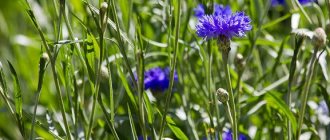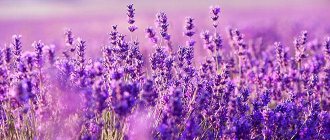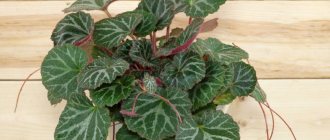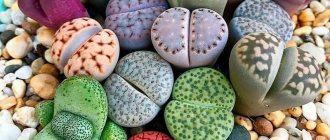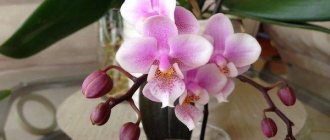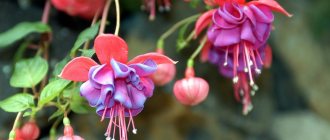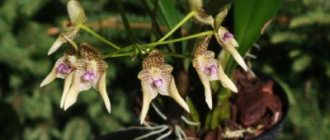Author: Elena N. https://floristics.info/ru/index.php?option=com_contact&view=contact&id=19 Category: Garden plants Published: February 13, 2019Last edits: October 18, 2021
- Where and when to plant
- Growing conditions
A drink from the heather Forgotten a long time ago. And he was sweeter than honey, Drunker than wine...
grass (lat. Calluna vulgaris) is an evergreen plant, the only species of the Heather genus of the Ericaceae family, which today numbers about 500 varieties, many of which have high decorative qualities. Heather grows in Europe, extending from the tundra to the coniferous-deciduous forest zone, in Greenland, North Africa, the Azores, temperate Asia and the Atlantic coast of North America, preferring forests, peat bogs and burnt areas. An old Scottish legend tells that heather was the only plant that agreed, at the request of the Creator, to grow on the bare rocky hills blown by the wind, as a reward for which it was endowed with endurance, unpretentiousness, a pleasant aroma and a modest but alluring charm. And to this day, where heather grows, nothing else grows - large areas covered with heather are usually called heather heaths. By the way, it was heather that gave the name to September in the Ukrainian, Belarusian and Polish languages - veresen, verasen, wrzesien.
Planting and caring for heather
- Planting: sowing seeds for seedlings is carried out at the end of March (or at the beginning of April), and two years later, the grown seedlings are planted in the ground in the second half of April (or at the beginning of May), but it is still better to do this at the end of September (or at the beginning of October).
- Flowering: July-August.
- Lighting: bright sunlight or light partial shade.
- Soil: wet peat or dry sandy soils with a pH of 4.5-5.5. Heather is not grown in limed soils.
- Watering: once every one and a half to two weeks.
- Humidity: higher than usual. In hot weather, the plant requires evening spraying.
- Feeding: in April or May with complete mineral fertilizer.
- Reproduction: by dividing the bush, apical cuttings, layering and seeds.
- Pests: practically not affected.
- Diseases: gray rot, powdery mildew, rust, viral infections.
- Properties: heather grass has wound-healing, cleansing, anti-inflammatory, diuretic, expectorant, disinfectant, anti-acid and soothing properties.
Read more about growing heather below.
If you purchased seedlings
It is preferable to plant rooted heather plants in the garden in a designated place around May. If it is decided to plant in the fall, then it should be done no later than September so that the seedlings can get stronger and take root before the onset of cold weather.
It is recommended to purchase heather from garden centers or specialized nurseries. Bushes are sold in plastic pots.
How to grow heather in a garden plot? Before planting, purchased seedlings need to be well watered. After carefully removing the heather from the container, carefully straighten the roots, which are usually collected in a lump. A bush with tangled roots will not be able to actively take root for a long time and will die.
A wide hole is prepared for the heather. They never dig it deep, since the roots of the bush are located close to the surface. If the soil in the selected area is clayey and does not conduct water well, arrange drainage. Excessive moisture only harms heather. To do this, before planting the plant, pour a couple of centimeters of pebbles or medium-fraction crushed stone into the planting hole. Then water is poured into it, the seedling is placed, covering it with soil no higher than the root collar.
After planting the plant, the soil needs to be compacted with your hands and watered again. Then the bed around the seedling is mulched with fallen pine needles or peat. Even the bark of coniferous trees is suitable for use.
Botanical description
The heather plant is a strongly branching, creeping evergreen shrub from 30 to 70 cm high with small triangular leaves, as if rolled into a tube, and small, fragrant, bell-like pink-purple flowers collected in one-sided brushes. Heather blooms in mid-summer, and reaches the peak of its beauty after the first frost, when its leaves acquire yellow and burgundy shades.
Heather was glorified in Robert Louis Stevenson's ballad “Heather Honey,” which we have known since childhood. And let someone think that the story described in poetry is fiction, but the fact that heather is an excellent honey plant, and the honey from it surpasses any other honey in healing qualities, is the true truth. Landscape designers prefer to plant heather along garden paths, on alpine hills, in borders, against the backdrop of dwarf conifers.
- How to plant freesia in open ground correctly
wild nature
Common heather is the name given to a pretty, beautifully flowering, hardy and most unpretentious shrub. It is believed that he set off on his journey around the world from Southeast Asia. Most often, these shrubs are found in pine, light mixed forests. Heather can choose peat or forest burnt areas. You can clearly see what heather looks like in the photo.
The plant is a bush of many shoots. They are densely covered with very small leaves of an unusual triangular shape. Heather shoots play with a variety of green shades. There are varieties of heather that have reddish leaves. There are unusual, attractive colors in muted copper, bright yellow or silver.
The small flowers of the plant are collected in dense inflorescences of six to thirty pieces. Usually in late summer - early autumn, the heathers are colored with deep purple, delicate pink, snow-white and even bright yellow. Under natural conditions, heather shrubs reach a height of approximately twenty-five centimeters.
An amazing long-living plant. There are specimens thirty and even fifty years old. They reach a diameter of more than three meters! In such a huge bush, the branches fall on the soil and take root, creating layering. But usually in nature, heather reproduces by seeds. Young bushes bloom when they reach the age of five years. Heather is an excellent honey plant that provides food for bees and many other insects.
Growing heather from seeds
How to sow seeds
Growing heather from seeds is a rather lengthy and labor-intensive process, but the high degree of seed germination - about 90% - inspires optimism. Heather seeds are placed in a bowl on top of a moistened substrate in a thin layer, without covering, and kept under glass until shoots appear.
The best substrate for germinating seeds is a mixture of coniferous soil, sand and peat in a ratio of 1:1:2. Crops need to be kept at a temperature of about 20 ºC, and for the first week it is necessary to create a high level of humidity for the seeds. Sprouts begin to appear after a month. As soon as the shoots appear, they begin to harden, briefly lifting the glass for ventilation. As soon as the seedlings grow and begin to interfere with each other, they are planted in containers or pots.
Seedling care
With the onset of summer, the seedlings are taken out into the garden and placed in partial shade, watering as needed, and with the onset of cold weather, the container is brought into a room where the air temperature is maintained within 10-12 ºC. Heather seedlings are planted in a permanent place after two years. It should be remembered that heather from seeds does not inherit its parental characteristics, but as a result of your efforts, a new variety may appear, which, quite possibly, will become your personal achievement.
Reproduction methods
Heather can be propagated by seedlings and seeds, and both methods give good results. If you maintain the temperature regime at home, you can grow heather at any time of the year.
Seedlings
Reproduction using seedlings is a fairly quick and easy way. Cuttings for this purpose should be:
- flexible;
- with vegetative buds at the ends;
- annuals;
- no flowers;
- from the tops of the bushes.
It is recommended to plant them in special pots, in a peat-sand mixture. Choose autumn for breeding.
Seeds
Seeds are the most reliable way to propagate heather. Germination is 90%, and seed planting is less affected by the time of year. However, seeds require more time and labor than seedlings. Sowing occurs as follows:
- Water the finished soil with warm water.
- Place the seeds on the ground, lightly press them down and sprinkle soil on top.
- To prevent the soil from drying out, cover the pot with film.
The seeds germinate in about a month. You can also keep the seeds outside the ground, in cups or saucers. To do this, they are laid out in a container in a thin layer, watered with water and also hermetically sealed. After the first shoots appear, they are planted in pots.
Planting heather in open ground
Where and when to plant
The best time for planting heather in open ground is from the end of September to the beginning of October and from the second half of April to the beginning of May, however, spring planting of heather is preferable to autumn. Heather loves open sunny areas, although it can grow in partial shade. Heather does not like calcareous soils, preferring dry sandy or moist peaty soils.
Heather does not pretend to make the soil fertile, but the pH value of the soil in the area should be shifted to the acidic side - pH approximately 4.5-5.5. The optimal soil composition for heather is peat, sand, coniferous soil or tree bark compost in a ratio of 3:1:2. The area where heather grows must be protected from strong winds. To acidify the soil, red high peat is added to it.
How to plant
Heather is planted at a density of approximately 6-10 specimens per 1 m², depending on the variety. The planting depth of the heather bush is 25-35 cm, the root collar should be flush with the surface of the site. If the soil on the site is clayey, in each hole you need to place a layer of drainage made of broken brick or sand with a layer of 5-10 cm. When planting heather, add 20-30 g of nitrophoska and 30-50 g of horn flour into the holes. After planting, water the heather seedlings at the rate of 5-6 liters of water for each heather bush and be sure to mulch the area with peat or coniferous wood chips. It remains to add that heather does not tolerate transplantation well, so try to think through all the steps and comply with all the requirements of agricultural technology so that the heather does not have to be replanted.
April
When the snow melts, you need to trim the heather bushes to the height of the faded flower stalks. It is very important to do this before the shoots begin to grow. Otherwise, pruning will bring harm, not benefit. You should also remove all broken and dried branches.
If the soil has subsided over the winter and the root collar of the plant is above its level, it is necessary to add fresh soil. It’s good if it’s a mixture of compost, sand and high-moor peat. It is also advisable to lightly mulch the bushes with fine pine bark, wood chips or gravel.
At the end of spring, when warm weather sets in, the heather must be fed with acidic fertilizers recommended for rhododendrons and hydrangeas. In order for the shrub to grow and develop well, the acidity of the soil should be from 3.5 to 5.5 pH.
For feeding, you can also use universal complex fertilizers with basic microelements. But in this case, the soil must be additionally acidified using acidic peat or colloidal sulfur.
Heather cannot be fed with fresh organic matter. Only rotted compost is allowed.
If the weather is dry, the heather needs to be watered. At this time, young shoots are actively appearing on the plant, and if there is a lack of moisture, the bush will not be lush. Also in June, it is important to ensure that the heather garden is not overgrown with weeds.
This month, flower buds form on young shoots, and excess moisture slows down this process. Therefore, in July, heather does not need additional watering.
If flowering shoots grow very slowly, you can feed the heather with fertilizer that does not contain nitrogen. For example, magnesium sulfate, potassium magnesium, potassium phosphate are suitable. But it should be noted that any fertilizers must be applied to moist soil.
Heather care
Growing conditions
The roots of heather are short and are not able to extract moisture from the depths of the soil, therefore, in the absence of regular rainfall, heather needs to be watered with acidified water - the soil on the site should be slightly moist at all times. It is this reason that makes it necessary to mulch the soil in the heather. In addition, mulch protects the soil on the site from overheating on hot days.
Watering is carried out once every one and a half to two weeks. After moistening the soil, it is advisable to loosen the soil to a depth of 10-15 cm while simultaneously removing weeds. Loosening and weeding are carried out through the mulch. In hot weather, heather can suffer from too dry air, so it responds well to nightly spraying.
As for fertilizing, every year in the spring (in April-May) complete mineral fertilizer should be added to the soil at the rate of 20-30 g/m² or 1.5-2 tablespoons for each adult plant. This is done in this way: dry fertilizer is scattered over the area, trying not to get on the leaves and flowers of the heather, otherwise burns may occur on them. Then the fertilizers are incorporated into the mulch, and the area is watered abundantly.
Heather needs annual spring pruning to maintain the desired shape and stimulate the growth of young shoots. However, intensive pruning of heather begins only in the third year from the moment of planting. Try to maintain the shape of the crown. The haircut is done as follows: hold the heather inflorescence by the top with your left hand, and cut off 2/3 or half of the inflorescence with your right hand. Vegetable trimmings can be shredded and scattered around the area as additional mulch.
Diseases and pests
Heathers are resistant to diseases and pests and are rarely affected, mainly by fungi or viruses. Most often, heather suffers from gray mold, and this occurs from stagnation of water in the roots, if the soil on the site is not characterized by good water permeability, and in the spring the snow melts too quickly. Gray rot manifests itself as a coating on the shoots, their death and falling leaves.
To combat the disease, heather is treated with fungicides, among which Fundazol and Topaz have the best effect, and in case of more severe damage, plants are sprayed with a one percent solution of copper sulfate. This treatment is carried out three times with an interval of 5-10 days. Good results are obtained by preventive spraying of heather with fungicides in the spring, after removing its cover, and in late autumn, before preparing the heather for wintering.
When heather is affected by powdery mildew, young shoots begin to dry out, and the leaves become covered with a whitish, loose coating. Red-brown spots on the leaves indicate heather rust infection. Both powdery mildew and rust are fungal diseases, so they need to be combated with fungicides, just like gray mold.
- Currants: growing in the garden, types and varieties
If you notice deformed shoots or flowers on heather, if the color of flowers and leaves has become uneven and uncharacteristic for the heather variety, you are most likely dealing with a viral disease, which, alas, is incurable. Dig up the diseased bushes and burn them, and spill the place where they grew with a strong solution of potassium permanganate.
But if your heather grows on suitable soil and receives appropriate agricultural care, it will not be afraid of any diseases.
Heather propagation
We have already described the process of heather seed propagation to you. Heather also reproduces vegetatively - by dividing the bush, layering and cuttings. The apical cuttings are taken at the end of summer from the strongest non-flowering branches and rooted in pots with a mixture of sand and peat (1:3), maintaining the room temperature within 15-18 ºC, and the soil slightly moist. Once a month or a month and a half, feed the cuttings with a urea solution at the rate of 1 g per 1 liter of water and microfertilizers. In spring, rooted cuttings can be planted in open ground.
Heather often propagates itself by layering, without any effort on your part: over time, its old branches lie to the ground and take root on their own. If you want to carry out this type of propagation, bend the lowest of the mature shoots, pin them to the soil and cover with a centimeter layer of peat, and after a year, separate the finished seedling from the mother bush and transplant it to a new place.
The easiest way to propagate heather is by dividing the rhizomes. This can also be done at the end of summer: dig up a mature bush and, without clearing the roots from the soil, cut it into pieces so that each section contains young shoots and roots. Old stems are cut off before planting, and the cuttings are planted in separate holes, having previously treated the sections with crushed coal.
Heather diseases
With proper agricultural technology, heather shrubs are not affected by diseases and pests. They can get sick under unfavorable growing conditions.
Powdery mildew and rust
The fungal disease manifests itself as a flour-like white coating on the leaves and drying out of young shoots. If the plant is affected by rust, red-brown spots appear on the leaves.
If the disease is not treated, the plants will die. Therefore, at the first signs of rust or powdery mildew, the bushes should be sprayed with a solution prepared from fungicides.
Heather after flowering
In warm areas, heather overwinters without shelter, but if you experience frosty winters, and even without snow, then it is better to play it safe and prepare the heather for wintering. To do this, after the onset of cold weather, spread peat around the heather bushes, and cover the bushes themselves with spruce branches, which will prevent them from freezing in winter, and in early spring will protect them from sunburn. Remove the cover from the heather in April.
Suitable soil
The plant prefers to live on peaty, acidic soil. It begins to hurt if planted in soil with an alkaline reaction. He doesn’t want to put up with an excess of organic matter. In such cases, watering the heather with water acidified with ordinary table vinegar will help. We will have to urgently start preparing suitable soil.
For the comfortable existence of this graceful shrub, a mixture of components is ideal:
- high-moor peat – 3 parts;
- river sand – 1 part;
- pine sawdust – 1 part;
- soil from under growing conifers - 1 part.
Types and varieties
There is only one species in the genus - common heather (Calluna vulgaris). Very often, heather is called the related erica, as well as its types and varieties, but no matter how similar erics are to heather, they are still different plants. The common heather species is represented by a huge number of beautiful varieties - today there are about five hundred of them. Gardeners divide them into six groups.
Group one. Varieties of heather with green leaf color:
- Allegro is an evergreen shrub up to 60 cm high and a crown diameter of about half a meter. The bark is dark brown, the crown is dense, compact, the leaves are dark green, scale-like. It blooms from late July to late October with simple, shiny carmine-red flowers in long inflorescences. The variety is winter-hardy and requires shelter for the winter only when young;
- Carmen is a Dutch hybrid variety, most popular in Europe. The crown is rounded, the height of the bush is 30-40 cm, the bark is dark brown, the leaves are small, dark green, the flowers are simple, violet-pink, on peduncles more than 10 cm long. It is winter-hardy, but it is better to cover it for the winter.
In addition to the described varieties of this group, Radnor, Duckness, Ross Hutton, Mazurka, Marco, Barnett Enley, Hookstone and others are also popular.
Group two. Varieties with green leaves and white flowers.
- Alba is an erect bush up to 40 cm tall with a crown diameter of up to 55 cm, with ascending branches, bright green leaves and dense clusters of white flowers;
- Alexandra is a spherical bush up to 30 cm high and a crown diameter of up to 40 cm with dark green leaves and creamy flowers, which acquire a dark red hue towards the end of flowering.
The following varieties of the group are also known: White Lon, Humpty Dumpty, Long White, Alec Martin, Alba Jay and others.
Group three. Varieties with silver leaves.
- Silver Knight is an English variety up to 30 cm high and a crown diameter of up to 45 cm with a compact, pillow-shaped crown, dark brown bark, fluffy, silver-gray leaves that take on a burgundy hue in winter. The flowers are simple, lilac or light purple, inflorescences up to 20 cm long. Winter-hardy, but in cold winters requires shelter;
- Peter Sparks is also an English variety up to half a meter high and up to 60 cm in diameter. The crown is oval, the bark is dark brown, the leaves are small, scale-like, dark green in summer and autumn, and gray-green in spring and winter. The flowers are double, dark pink, densely collected in inflorescences up to 30 cm long. Moderately winter-hardy.
Also popular varieties of this group are Annmarie, Velvet Fashion, Jan Dekker, Glendwick Silver and others.
Fourth group. Varieties with golden leaves.
- Plum: growing in the garden, types and varieties
- Andrew Proudley - up to 15 cm high and about 25 cm in diameter with thin, widely ascending branches. The leaves, which are orange with pale yellow tips in warm weather, take on a bronze hue in winter. Small pink flowers are collected in loose inflorescences;
- Boskup is a Dutch variety up to 40 cm high, up to 50 cm in diameter with a compact crown, dark brown bark, yellow-green leaves in the summer, which turn copper-red in the fall. The flowers are simple, pink-lilac, collected in short, slightly branched inflorescences up to 10 cm long. Moderately winter-hardy.
The varieties Aura, Arran Gold, Blazeway, Crimson Sunset, Gold Hayes, Cottswood Gold and others are also of interest.
Fifth group. Varieties with double flowers.
- Autumn Glow is a spreading shrub up to 30 cm high and a crown diameter of about 45 cm with branches rising at the ends. The leaves are dark green, densely double light purple flowers are collected in short dense racemes;
- Monica is a wide-spreading bush with a diameter of up to 80 cm and a height of about 55 cm. The branches are strong, widely ascending, the leaves are dark green, with a gray coating in winter. Very large double flowers in dense clusters of pinkish-red hue.
Other popular varieties: Red Favorite, Dark Star, Alba Plena, Joan Sparks, County Wicklow.
Group six. Varieties with indehiscent flowers.
- David Eason - a spherical bush up to 20 cm high and a crown diameter up to 25 cm, with numerous ascending branches, dark green leaves and dark mauve flowers collected in short racemes;
- Marlin is a German variety up to 30 cm high, crown diameter up to 50 cm. The bark is dark brown, the leaves are small, dark green. The never-opening buds are bright purple or lilac-pink.
Other varieties: Romina, Minima, Fritz Kircher.
Introduction
The plant gave its name to the first autumn month, which among the Slavic peoples is called “Veresen”. Heather is an excellent honey plant from which bees collect the last pollen of the year. Heather honey is not just a beautiful legend, sung by Robert Stevenson in the poem of the same name, it is a wonderful reality.
Modern landscapes are decorated with more than 500 varieties, which are planted in separate gardens or rock gardens.
From a botanical point of view, the species Common Heather (Calunea vulgaris) is characterized as a semi-evergreen subshrub. Its shoots become woody partially in the lower part, and small leaves remain green only at the ends of the branches.
Like most representatives of the family of the same name, it is able to survive exclusively in close union with fungal mycelium. The plant extracts nutrients from poor soil thanks to fungal threads - hyphae.
Natural heather plantations are found in the northern part of the Eurasian continent
Under the stems of creeping plantings, a specific gray sandy soil is formed, in which nitrogen, phosphorus, potassium and other elements are virtually absent. Only thanks to beneficial microorganisms does the plant receive the necessary nutrition. The shrub will not grow in a personal plot if such microflora is absent.
Orange: description, planting, growing at home, propagation and care (Photo & Video) + Reviews
Properties of heather
The medicinal properties of heather are in demand in both folk and traditional medicine. It is used to treat cough, kidney disease, cystitis, pyelitis, urethritis, dysentery, diarrhea, gastritis, enterocolitis, rheumatism, gout, and skin diseases.
Blooming heather is harvested from the end of June to September - it is at this time that it contains the maximum amount of useful substances: flavonoids, mineral salts of phosphorus, potassium, calcium and sodium, organic acids. These substances give heather a disinfectant, anti-inflammatory, diaphoretic, wound-healing, diuretic, expectorant, cleansing, astringent and soothing effect.
Heather decoction is used for insomnia and nervous system disorders, vascular atherosclerosis, gastrointestinal diseases, hyperacidity, cholecystitis and obesity. Inflammation of the mouth and throat is relieved by rinsing with a decoction, and for tuberculosis, an alcoholic infusion of heather is taken internally. Powder from crushed heather flowers is used to treat ulcers, wounds, eczema and burns. Heather baths are prescribed for radiculitis. An infusion of heather flowers, rubbed into the scalp, slows down the process of hair loss and improves its appearance.
Heather has no contraindications, but before taking medications from it, it is better to consult with an experienced doctor. It is not recommended to use heather internally for people with low acidity of gastric juice.

